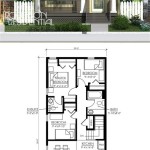Simple House Plans: Build Your Dream Home Hassle-Free
The aspiration of owning a home is a common and deeply personal one. The realization of this aspiration often involves navigating a complex process, with house plans serving as the foundational blueprint for the entire project. Simplifying this process, particularly focusing on readily available and easily understood house plans, can significantly reduce stress and streamline the construction process. This article explores the advantages of using simple house plans and how they can contribute to a hassle-free home building experience.
Simple house plans generally prioritize functionality and cost-effectiveness. They are typically characterized by straightforward layouts, minimal ornamentation, and efficient use of space. This approach offers significant benefits for both experienced builders and first-time homeowners looking to minimize complexities and control expenses. The accessibility of simple plans across various architectural styles allows for personalization without overwhelming the building process.
Understanding the Benefits of Simple House Plans
Choosing a simple house plan yields numerous advantages, especially in terms of cost, construction time, and adaptability. These benefits are critical for homeowners looking for a streamlined and efficient building process.
Cost Efficiency: Simple designs typically require fewer materials and less specialized labor. The rectangular or square footprints common in simple plans minimize waste during construction. Walls are straight, minimizing the need for custom cuts and intricate framing. Furthermore, simpler roof designs, such as gable or hip roofs, are less expensive to build than more elaborate designs with multiple pitches and dormers. This translates to significant savings on both material and labor costs, making homeownership accessible to a wider range of individuals and families.
Reduced Construction Time: The uncomplicated nature of simple house plans translates directly to faster construction timelines. Straightforward layouts and minimal detailing allow builders to complete projects more quickly. This reduction in time is not only convenient for the homeowner but also contributes to further cost savings, as it reduces the amount of time contractors are on-site. A quicker build also means less disruption for the surrounding neighborhood and faster occupancy for the homeowner.
Ease of Modification: While simple plans offer a straightforward design, they can be easily adapted to meet specific needs. Interior walls can be reconfigured to create larger or smaller rooms. Windows and doors can be added or relocated with relative ease. Furthermore, incorporating sustainable features, such as solar panels or rainwater harvesting systems, often integrates seamlessly with simpler designs. This adaptability allows homeowners to personalize their space without significantly increasing costs or complicating the construction process.
Lower Maintenance Costs: Simple designs often translate to lower long-term maintenance costs as well. With fewer intricate details, there are fewer areas prone to damage or requiring specialized upkeep. For example, simpler rooflines are less susceptible to leaks and require less frequent cleaning. Similarly, straightforward siding options are easier to repair and maintain than more complex architectural finishes. These reduced maintenance requirements contribute to significant cost savings over the lifespan of the home.
Key Considerations for Selecting a Simple House Plan
Selecting the right simple house plan requires careful consideration of various factors, including lifestyle, budget, lot size, and local building codes. Evaluating these factors upfront is crucial for ensuring a successful and satisfying home-building experience.
Lifestyle and Needs: The most important aspect of choosing a house plan is ensuring that it aligns with the homeowner’s lifestyle and needs. Consider the number of bedrooms and bathrooms required, as well as the desired size and layout of living spaces. Families with young children may prioritize open floor plans and play areas, while those who work from home may need a dedicated office space. Think critically about how the space will be used on a daily basis and choose a plan that supports those activities. The number of occupants, the nature of hobbies, and preferences for entertaining should all influence the selection process.
Budget Allocation: While simple house plans are generally more cost-effective, it's imperative to establish a clear budget before making any decisions. Consider not only the cost of the house plan itself, but also the cost of materials, labor, permits, and landscaping. Obtaining quotes from multiple contractors can help to ensure accurate cost estimations. Establishing a contingency fund to cover unexpected expenses is also advisable. By carefully planning and managing the budget, homeowners can avoid financial surprises during the construction process.
Lot Size and Orientation: Before selecting a house plan, assess the size and orientation of the building lot. Different house plans are suited to different lot sizes and shapes. Furthermore, the orientation of the lot can influence the placement of windows and doors to maximize natural light and ventilation. Consider the location of existing trees, utility lines, and neighboring buildings. Working with a surveyor can help to accurately assess the lot and ensure that the chosen house plan is compatible with the available space and site conditions.
Local Building Codes and Regulations: Compliance with local building codes and regulations is essential for ensuring a safe and legal construction project. Research local zoning ordinances, setback requirements, and height restrictions before selecting a house plan. Some areas may have specific requirements regarding energy efficiency, fire safety, or accessibility features. Working with a local architect or contractor who is familiar with local building codes can help to navigate these regulations and ensure that the project is fully compliant. Failure to comply with building codes can result in delays, fines, or even demolition of non-compliant structures.
Finding and Utilizing Simple House Plan Resources
Numerous resources are available to assist homeowners in finding and utilizing simple house plans. These resources range from online databases to local architects and contractors, each offering unique advantages and services.
Online Plan Databases: A multitude of websites offer a vast selection of house plans, ranging from simple and affordable designs to more elaborate and customized options. These databases typically allow users to search by square footage, number of bedrooms, architectural style, and other criteria. Many plans include detailed floor plans, elevations, and 3D renderings. However, it is crucial to carefully review the plans and ensure that they meet the homeowner’s needs and local building codes. Some websites also offer customization services, allowing homeowners to modify existing plans to suit their specific requirements. Always verify the credibility and reputation of the website before purchasing a plan.
Architectural Design Services: Consulting with an architect can provide valuable assistance in selecting or modifying a simple house plan. Architects can assess the homeowner’s needs and preferences, evaluate the building lot, and ensure compliance with local building codes. They can also provide design expertise to optimize the layout, aesthetics, and functionality of the home. While hiring an architect may be more expensive than purchasing a pre-designed plan, it can result in a more customized and well-designed home that meets the homeowner’s specific needs and budget. Furthermore, an architect can oversee the entire construction process, ensuring that the project is completed to a high standard.
Partnering with a General Contractor: A general contractor can provide valuable expertise in managing the construction process. They can obtain necessary permits, coordinate subcontractors, and ensure that the project is completed on time and within budget. When selecting a contractor, it's important to obtain multiple bids, check references, and verify that they are licensed and insured. A good contractor will have experience working with simple house plans and be able to provide valuable advice on cost-saving measures and construction techniques. Clear communication and a well-defined contract are essential for a successful working relationship with a general contractor.
By carefully considering these factors and utilizing available resources, homeowners can successfully navigate the process of building their dream home using simple house plans, making the construction journey a more manageable and enjoyable accomplishment.

Yet Another Floor Plan Idea And The Awesome Free Trial Program I Used To Create It Addicted 2 Decorating

Free Floor Plan Creator

16 Cutest Tiny Home Plans With Cost To Build Craft

Yet Another Floor Plan Idea And The Awesome Free Trial Program I Used To Create It Addicted 2 Decorating

16 Cutest Tiny Home Plans With Cost To Build Craft

Free Floor Plan Creator

Yet Another Floor Plan Idea And The Awesome Free Trial Program I Used To Create It Addicted 2 Decorating

5 Tips For Designing Your Dream Home On A Computer Kevin Szabo Jr Plumbing Services Local Plumber Tinley Park Il

Yet Another Floor Plan Idea And The Awesome Free Trial Program I Used To Create It Addicted 2 Decorating

16 Cutest Tiny Home Plans With Cost To Build Craft
Related Posts








